

Kletsk (Kletzk, Kleck, Kliecak, Klieck, Klechesk, Klyetsk) is a small town in present-day Belarus, 113 km (69 miles) southwest of the capital city of Minsk. Prior to World War II, Kletsk contained a vibrant Jewish community.
These pages are a resource and a focus point for anyone seeking more information about the Jewish community in Kletsk. Contributions from the community of Kletsker descendants and others are essential to fulfilling our obligation to reconstruct the lives, and --especially-- the joys of our ancestors. These pages are a team effort: a product of work by Kletskers and members of the wider community, within JewishGen and beyond. View Acknowledgements.
For more information about me, to contribute, to suggest corrections, or to share reflections about Kletsk and the process of remembering, contact the coordinator. Please check the wish list, too.
Hint: You may click on most small pictures ("thumbnails") on these pages to see larger versions and, in many cases, supplementary information.
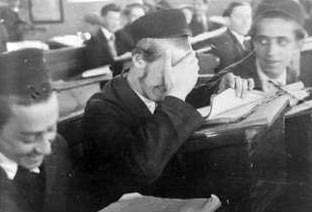 How
can I find out more about my Kletsker ancestors?
How
can I find out more about my Kletsker ancestors?
![]() 1920s-30s. Boys in a yeshiva reacting with embarrassed laughter to the presence
of a photographer. Courtesy of YIVO.
1920s-30s. Boys in a yeshiva reacting with embarrassed laughter to the presence
of a photographer. Courtesy of YIVO.
The JewishGen Home Page is your most comprehensive guide to Jewish genealogy.
The Belarus Special Interest Group (SIG) gives more specific support, including this search page for locating Belorussian ancestors and their shtetls.
Yizkor ("Memorial") Books were compiled by survivors. The JewishGen Yizkor Book Project is dedicated to giving access to Yizkor Books, unique, primary sources for genealogy and history.
The Kletsk Yizkor Book lists 900 Kletsk residents. View the original, in Hebrew/Yiddish, in image form at the New York Public Library. View the Table of Contents and the Name Index of the Kletsk Memorial Book Translation Project at JewishGen.
The Central Database at Yad Vashem lists information about Holocaust victims with ties to Kletsk. Recent searches disclose 900 people who were born in Kletsk, 900 individuals who lived in Kletsk before W.W.II, 800 people who lived in Kletsk during the war, and 900 individuals who died in Kletsk. The information in the Pages of Testimony often includes parents, siblings, and children. The submitter of information is often identified, and he/she or a descendent can sometimes be located. This information can be used to reconstruct family trees and locate survivors.
Ellis Island resources list Kletskers who emigrated to the U.S. view the names of 750 Kletsker arrivals 1900-1924. By examining the original Ellis Island documents, you may be able to gather additional information about members of families traveling together, family members, or landsmen already in the U.S., as well as those remaining behind.
It is impossible to overstate the contribution of Dr. Stephen Morse to making the Ellis Island data easily accessible. See his One-Step Search Page For Jewish Passengers. See also a supporting JewishGen article: Which One-Step Ellis Island Search Form Should I Use?
Please consider contributing your family genealogies to the Family Tree of the Jewish People. You may also find value in discussing genealogical information privately with other Kletsk descendents. Each of us may have a critical piece of the puzzle in our notes. For more information, Contact the Page Coordinator.
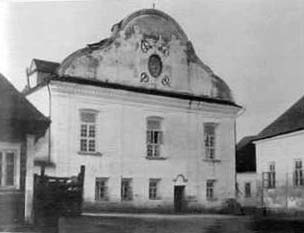 How
can I discover more about Jewish social, religious, and cultural life in pre-war
Kletsk?
How
can I discover more about Jewish social, religious, and cultural life in pre-war
Kletsk?
Date unknown.
The exterior of the synagogue. Courtesy of YIVO.![]()
The Kletsk Yizkor Book is our best available reference. View the original, in Hebrew/Yiddish, in image form at the New York Public Library. (Don't miss the pictures following page 172!) View the Names Index, part of the ongoing JewishGen Kletsk Memorial Book Translation Project.
View images at YIVO's People of a Thousand Towns online catalog. Registration required -- search for "Kleck", and compare images you see for other towns.
Historian Eugene M. Avrutin describes the development of Jewish legal status and political participation in the region, and describes some difficulties counting the Jewish population in Kletsk and environs, in an article in Jewish Social Studies, vol. 11, no. 2 (2005).
Official business surveys give us snapshots of communities, including summaries of government, infrastructure and population, as well as listing occupations and the names of those engaged in each. For Kletsk: the 1929 Polish Business Directory. (Unfortunately, at present, there does not seem to be a reliable way to link to the data. You'll need to follow the links.) This JewishGen Translation Guide gives English equivalents for names of occupations. View the occupation data for Kletsk on this page of the Nesvizh Study Group.
The Kletsk Yeshiva left during W.W.II, found its way to Lakewood, NJ and has since become a highly-respected institution for advanced study
Take a look at these family albums provided by Kletskers who are sharing their family history with us: Tarrow -- Pikoos -- Neugass.
It is said (my mother told me) that the men of Kletsk were considered unusually fine dressers, dandies of their region, and that the number of tailors in Kletsk was unusually large to serve this demand.
1928. Portion of a Polish map. Courtesy of Stanford University.
Kletsk is contained in the Slutsk Uyezed (equivalent to "County"), in Minsk Gubernia ("State") of Belarus at Latitude 53º04', Longitude 26º38'.
In the period before W.W.II, the area was governed alternately by Russia and Poland. (Thus a Kletsker might have remarked, "First, we're in Russia, then it's Poland. Back to Russia last year. Now it's Poland again. I'm glad -- those Russian winters were killing me.")
 How
can I learn about the relationship of Kletsk to other shtetlekh in the region?
How
can I learn about the relationship of Kletsk to other shtetlekh in the region?
![]() Date
unknown. On "the most beautiful street in town": a building superintendent (at
left) sweeps up a
section of the cobblestone is being repaired.
Courtesy of YIVO.
Date
unknown. On "the most beautiful street in town": a building superintendent (at
left) sweeps up a
section of the cobblestone is being repaired.
Courtesy of YIVO.
Kletsk was part of a virtually endless network of towns stretching across the region linked by heavily-traveled roads. It was expected that travelers would generally stay in their general area for fear of traversing unfamiliar roads in unfamiliar areas.
Kletsk is referenced as having several "dependent" villages, typically with populations of 500 or under: Kajszyce, Laukwcem, Micklewicze Wielkie, Polonkowicze, Zubki. Did these towns have Jewish populations? Documentation is scare.
Some facilities in Kletsk --most notably, the justice of the peace -- were shared with other area towns: Babajewicze, Cepra, Domatkanowicze, Holynka, Jakszyce, Kuchczyce, Lisowoko, Morocz, Panacz, Siniawka, Zaostrowiecze.
There are KehilaPages for neighboring towns, Lyakhovichi and Nesvizh. Take a look at these street scenes of Lyakhovichi, including this modern picture of Kletsker Road (scroll down) between Lyakhovichi and Kletsk. Excepting the utility poles, is that what our ancestors would have seen in the early 20th century? Picture
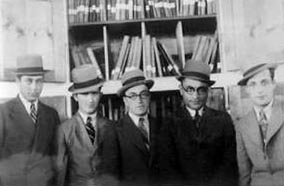 What
traces of historical Kletsk can I find in the Israel and the U.S.?
What
traces of historical Kletsk can I find in the Israel and the U.S.?
![]() 1920s-30s. Young men posing in a library. Courtesy of YIVO
1920s-30s. Young men posing in a library. Courtesy of YIVO
A Kletsk Holocaust Memorial is one of many at Holon Cemetery, near Tel Aviv, Israel
Landsmanshaften organizations provided camaraderie to emigrants and support to people remaining in the old country. Most have long since disbanded, but their records provide reflections of the old country. Two extraordinary exceptions: both The Kletzker Young Men's Benevolent Association (KYMBA) and the Independent Kletzker Brotherly Aid Associaton exist to this day! Kletskers are resilient!
The Jewish Genealogy Society of New York offers this long list of American landsmanshaftn. The Center for Jewish History provides this brief research guide (PDF). This article provided by the Belarus Special Interest Group (SIG) summarizes these records and the process of accessing them. Three such organizations were the Independent Kletzker Brotherly Aid Society, the Kletzker Young Men's Benevolent Association, and the Independent Kletzker Brothers Unt. Verein. At one point there existed a combined labor (?) organization for Kletsk and neighboring Nesvizh, the Kletzker-Nisvizher branch of IWO.
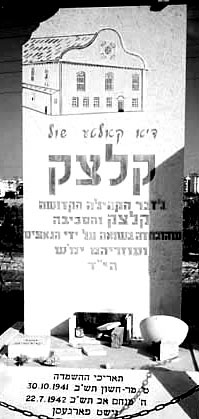 Where
can I find out more about the Holocaust in Kletsk?
Where
can I find out more about the Holocaust in Kletsk?
Kletsk
Memorial at Holon Cemetery (at Goush 11, Ezor 11), near Tel Aviv, Israel."
Courtesy of M.H.![]()
The Jewish population of Kletsk was obliterated by mid-1942.
The Soviets arrived two weeks after the start of war, on 17 September 1939. The Germans entered the town on 25 June 1941. Persecution and murder started immediately. The Black Friday of 24 October was a prelude to mass murder of some 6000 Jews six days later. On 22 July 1942, the Germans rounded up the remaining residents of the Kletsk Ghetto... and were met with armed resistance.
The papers of the late Elimelech Benari recounts the Holocaust in Kletsk and his return to his hometown. (Table of Contents) Read The Jews of Kletsk -- Their Destruction and Resistance, starting at Part1. Read his Eulogy For the Jews of Kletz, delivered at a memorial dedication in 1991.
Jews in Kletsk resisted the formation of a ghetto, and staged a revolt. Kletsker resistance is summarized at the United States Holocaust Memorial Museum (USHMM).
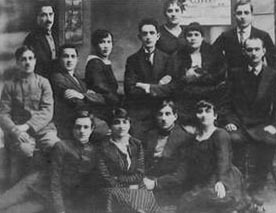 How
can I find other people interested in Kletsk?
How
can I find other people interested in Kletsk?
![]() Published July 11, 1926. Studio portrait of an amateur theatrical group. Courtesy
of YIVO
Published July 11, 1926. Studio portrait of an amateur theatrical group. Courtesy
of YIVO
Use the JewishGen Family Finder (JGFF) (registration required).
As of early 2005, there are about 90 people interested in finding their roots in Kletsk. You may also want to check the JGFF for neighboring towns for neighboring towns, Lyakhovichi and Nesvizh to search for similar names.
Contact the Kletsk Page Coordinator
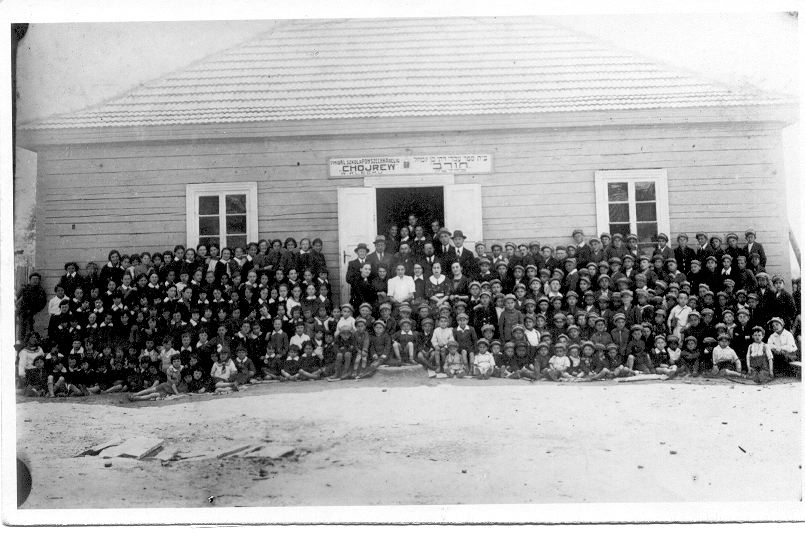 How
can I keep up to date with work others are doing?
How
can I keep up to date with work others are doing?
Date
unknown. The school. Courtesy of the Tarrow Family.![]()
Check these pages regularly! There is a "last-updated" date at the bottom of each.
Contact the Page Coordinator and ask to be put on the to-be-established mailing list and/or electronic newsletter.
How can I find out if my question about Kletsk (or these web pages) has already been answered?
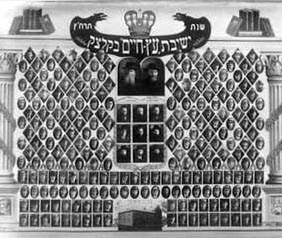
![]() 1938.
Portraits of the graduating class and staff of Etz Haim Yeshiva. Courtesy
of YIVO.
1938.
Portraits of the graduating class and staff of Etz Haim Yeshiva. Courtesy
of YIVO.
See these Frequently Asked Questions (FAQ).
Please keep in mind that your question well may open doors to new knowledge about Kletsk. Contact the Page Coordinator, discuss them with other Kletsk descendents, be persistant.
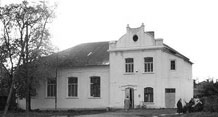 What
is the appearance of modern Kletsk?
What
is the appearance of modern Kletsk?
1999.
The Kletsk Synagogue. Courtesy of Risa Heywood.![]()
"Paved Over" are the kinds of words we hear reported, "Not much
left of the old appearance." One visitor reports that the river just to
the west, an important feature of Kletsk life in most histories we read, has
entirely disappeared. Still, there may be some features of the town that recall
the pre-war past.
A 1999 Trip to Minsk organized by ShtetlSchleppers (now apparently defunct) passed through Kletsk. Since 1990, one private, family visit is known to have occurred, and there was a memorial dedication ceremony that drew many visitors in 1991, 50 years after the final act of the Holocaust in Kletsk. For that occasion, the local museum had expanded to include an extensive display of local Jewish history and culture. Since then, apparently, the Jewish "wing" has been scaled back. (What happened to the items removed?)
Will you be the next to visit Kletsk? If so, please help your fellow Kletsker descendents recreate the lives of our ancestors. Collect a wish-list of needed information before you leave. Much data is obtainable only by visitors to the site -- and the more-prepared the visitors, the better. Working together, we may be able to open doors unavailable to individuals.
KehilaLinks Home | JewishGen Home
This page is hosted at no cost to the public by JewishGen, Inc., a nonprofit corporation.
If you feel there is a benefit to you in accessing this site, your JewishGen-erosity is appreciated.
Compiled and Created by Henry Neugass
| Contact: |
Last Updated: HDN 11-May-2025 10:58
Copyright © 2023 Henry Neugass